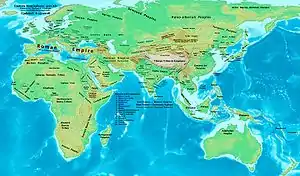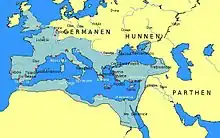| Millennium: | 1st millennium |
|---|---|
| Centuries: | |
| Decades: | |
| Years: |
| 400 by topic |
|---|
| Leaders |
| Categories |
|
| Gregorian calendar | 400 CD |
| Ab urbe condita | 1153 |
| Assyrian calendar | 5150 |
| Balinese saka calendar | 321–322 |
| Bengali calendar | −193 |
| Berber calendar | 1350 |
| Buddhist calendar | 944 |
| Burmese calendar | −238 |
| Byzantine calendar | 5908–5909 |
| Chinese calendar | 己亥年 (Earth Pig) 3097 or 2890 — to — 庚子年 (Metal Rat) 3098 or 2891 |
| Coptic calendar | 116–117 |
| Discordian calendar | 1566 |
| Ethiopian calendar | 392–393 |
| Hebrew calendar | 4160–4161 |
| Hindu calendars | |
| - Vikram Samvat | 456–457 |
| - Shaka Samvat | 321–322 |
| - Kali Yuga | 3500–3501 |
| Holocene calendar | 10400 |
| Iranian calendar | 222 BP – 221 BP |
| Islamic calendar | 229 BH – 228 BH |
| Javanese calendar | 283–284 |
| Julian calendar | 400 CD |
| Korean calendar | 2733 |
| Minguo calendar | 1512 before ROC 民前1512年 |
| Nanakshahi calendar | −1068 |
| Seleucid era | 711/712 AG |
| Thai solar calendar | 942–943 |
| Tibetan calendar | 阴土猪年 (female Earth-Pig) 526 or 145 or −627 — to — 阳金鼠年 (male Iron-Rat) 527 or 146 or −626 |

The Eastern Hemisphere in 400

Europe in 400
Year 400 (CD) was a leap year starting on Sunday (link will display the full calendar) of the Julian calendar. In the Roman Empire, it was known as the Year of the Consulship of Stilicho and Aurelianus (or, less frequently, year 1153 Ab urbe condita). The denomination 400 for this year has been used since the early medieval period, when the Anno Domini calendar era became the prevalent method in Europe for naming years.
Events
By place
Roman Empire
- January 9 – Emperor Arcadius gives his wife Aelia Eudoxia the official title of Augusta. She is able to wear the purple paludamentum and is depicted in Roman currency.
- Anthemius, praetorian prefect of the East, is sent on an embassy to the Persian capital, Ctesiphon, to congratulate King Yazdegerd I on his accession the year before.[1]
- A riot breaks out in Constantinople; the Great Palace is burned to the ground. Gainas, a Gothic leader, attempts to evacuate his soldiers out of the city, but 7,000 armed Goths are trapped and killed by order of Arcadius. After the massacre, Gainas tries to escape across the Hellespont, but his rag-tag ad hoc fleet is destroyed by Fravitta, a Gothic chieftain in imperial service.
- Winter – Gainas leads the remaining Goths back to their homeland across the Danube. They meet the Huns and are defeated; the Hunnic chieftain Uldin sends the head of Gainas to Constantinople, where Arcadius receives it as a diplomatic gift.
Europe
Asia
- Richū, the eldest son of Nintoku, becomes the 17th Emperor of Japan.
By topic
Art
- Resurrection and "Two Marys with Angel near the Empty Tomb", panel of a diptych, found in Rome, is made. It is now kept at Castello Sforzesco, Milan (approximate date).
Literature
- The Vergilius Vaticanus, an illuminated manuscript containing fragments of Virgil's Aeneid and Georgics, is made in Rome.
- The Yoga Sutras of Patanjali are composed.[2]
Medicine
- Caelius Aurelianus, Roman physician, is practising his work "De morbis acutis et chronicis" (Concerning Acute and Chronic Illness), a guide to acute and chronic diseases.
Physics
- Hypatia, Greek philosopher, distinguishes herself as one of the first female scientists, and becoming head of the Neo-Platonist school at Alexandria.
Religion
Births
Deaths
- Castor of Karden, Christian priest and hermit
- Duan, Chinese empress and wife of Murong Bao
- Gainas, Gothic chieftain and general (magister militum)
- Li Lingrong, empress and mother of Jin Xiaowudi
- Lü Guang, emperor of the Di state Later Liang (b. 337)
- Lü Shao, "Heavenly Prince" (Tian Wang) of Later Liang
- Oribasius, Greek medical writer and physician
References
This article is issued from Wikipedia. The text is licensed under Creative Commons - Attribution - Sharealike. Additional terms may apply for the media files.